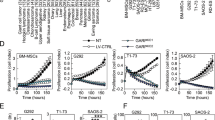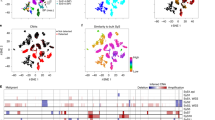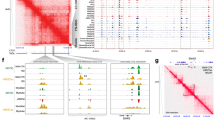Abstract
Synovial sarcoma is an aggressive soft tissue tumor characterized by a specific chromosomal translocation between chromosome 18 and X. This translocation can generate a fusion transcript encoding SYT-SSX1, a transforming oncoprotein. We present evidence that SYT-SSX1 induces insulin-like growth factor II expression in fibroblast cells. SYT-SSX2, a fusion also frequently found in synovial sarcoma, is necessary for maintaining Igf2 expression in the synovial sarcoma cell line, and the increased IGF2 synthesis protects cells from anoikis and is required for tumor formation in vivo. We also found a loss of imprinting (LOI) for Igf2 in a limited number of primary synovial sarcomas despite demethylation of CpG dinucleotides critical for maintaining imprinting. These findings suggest that inhibition of the IGF2/IGF1-R signaling pathway may represent a significant therapeutic modality for treating synovial sarcoma.
This is a preview of subscription content, access via your institution
Access options
Subscribe to this journal
Receive 50 print issues and online access
$259.00 per year
only $5.18 per issue
Buy this article
- Purchase on Springer Link
- Instant access to full article PDF
Prices may be subject to local taxes which are calculated during checkout





Similar content being viewed by others
Accession codes
References
Allander SV, Illei PB, Chen Y, Antonescu CR, Bittner M, Ladanyi M et al. (2002). Am J Pathol 161: 1587–1595.
Assoian RK, Grotendorst GR, Miller DM, Sporn MB . (1984). Nature 309: 804–806.
Bartolomei MS, Tilghman SM . (1997). Annu Rev Genet 31: 493–525.
Baserga R . (1994). Cell 79: 927–930.
Bell AC, Felsenfeld G . (2000). Nature 405: 482–485.
Brett D, Whitehouse S, Antonson P, Shipley J, Cooper C, Goodwin G . (1997). Hum Mol Genet 6: 1559–1564.
Clark J, Rocques PJ, Crew AJ, Gill S, Shipley J, Chan AM et al. (1994a). Nat Genet 7: 502–508.
Clark SJ, Harrison J, Paul CL, Frommer M . (1994b). Nucleic Acids Res 22: 2990–2997.
Crew AJ, Clark J, Fisher C, Gill S, Grimer R, Chand A et al. (1995). EMBO J 14: 2333–2340.
Cui H, Onyango P, Brandenburg S, Wu Y, Hsieh CL, Feinberg AP . (2002). Cancer Res 62: 6442–6446.
DeChiara TM, Efstratiadis A, Robertson EJ . (1990). Nature 345: 78–80.
DeChiara TM, Robertson EJ, Efstratiadis A . (1991). Cell 64: 849–859.
Drummond IA, Madden SL, Rohwer-Nutter P, Bell GI, Sukhatme VP, Rauscher III FJ . (1992). Science 257: 674–678.
Eid JE, Kung AL, Scully R, Livingston DM . (2000). Cell 102: 839–848.
Felsenfeld G, Groudine M . (2003). Nature 421: 448–453.
Frevel MA, Hornberg JJ, Reeve AE . (1999). Trends Genet 15: 216–218.
Frommer M, McDonald LE, Millar DS, Collis CM, Watt F, Grigg GW et al. (1992). Proc Natl Acad Sci USA 89: 1827–1831.
Garcia-Echeverria C, Pearson MA, Marti A, Meyer T, Mestan J, Zimmermann J et al. (2004). Cancer Cell 5: 231–239.
Giannoukakis N, Deal C, Paquette J, Goodyer CG, Polychronakos C . (1993). Nat Genet 4: 98–101.
Hahn WC, Counter CM, Lundberg AS, Beijersbergen RL, Brooks MW, Weinberg RA . (1999). Nature 400: 464–468.
Hark AT, Schoenherr CJ, Katz DJ, Ingram RS, Levorse JM, Tilghman SM . (2000). Nature 405: 486–489.
Holmgren C, Kanduri C, Dell G, Ward A, Mukhopadhya R, Kanduri M et al. (2001). Curr Biol 11: 1128–1130.
Jackson AL, Bartz SR, Schelter J, Kobayashi SV, Burchard J, Mao M et al. (2003). Nat Biotechnol 21: 635–637.
Kato H, Tjernberg A, Zhang W, Krutchinsky AN, An W, Takeuchi T et al. (2002). J Biol Chem 277: 5498–5505.
Ladanyi M . (2001). Oncogene 20: 5755–5762.
Ladanyi M, Antonescu CR, Leung DH, Woodruff JM, Kawai A, Healey JH et al. (2002). Cancer Res 62: 135–140.
Lim FL, Soulez M, Koczan D, Thiesen HJ, Knight JC . (1998). Oncogene 17: 2013–2018.
Liu Q, Yan H, Dawes NJ, Mottino GA, Frank JS, Zhu H . (1996). Circ Res 79: 716–726.
Mitsiades CS, Mitsiades NS, McMullan CJ, Poulaki V, Shringarpure R, Akiyama M et al. (2004). Cancer Cell 5: 221–230.
Miyagishi M, Taira K . (2002). Nat Biotechnol 20: 497–500.
Nagai M, Tanaka S, Tsuda M, Endo S, Kato H, Sonobe H et al. (2001). Proc Natl Acad Sci USA 98: 3843–3848.
Nakagawa H, Chadwick RB, Peltomaki P, Plass C, Nakamura Y, de La Chapelle A . (2001). Proc Natl Acad Sci USA 98: 591–596.
Nielsen FC, Orskov C, Haselbacher G, Ramlau J, Christiansen J, Schmiegelow K et al. (1994). Cancer 73: 1312–1319.
O'Dell SD, Day IN . (1998). Int J Biochem Cell Biol 30: 767–771.
Ogawa O, Eccles MR, Szeto J, McNoe LA, Yun K, Maw MA et al. (1993). Nature 362: 749–751.
Ohlsson R, Nystrom A, Pfeifer-Ohlsson S, Tohonen V, Hedborg F, Schofield P et al. (1993). Nat Genet 4: 94–97.
Pal N, Wadey RB, Buckle B, Yeomans E, Pritchard J, Cowell JK . (1990). Oncogene 5: 1665–1668.
Pedone PV, Tirabosco R, Cavazzana AO, Ungaro P, Basso G, Luksch R et al. (1994). Hum Mol Genet 3: 1117–1121.
Qi CF, Martensson A, Mattioli M, Dalla-Favera R, Lobanenkov VV, Morse III HC . (2003). Proc Natl Acad Sci USA 100: 633–638.
Rabbitts TH . (1994). Nature 372: 143–149.
Rainier S, Johnson LA, Dobry CJ, Ping AJ, Grundy PE, Feinberg AP . (1993). Nature 362: 747–749.
Schmid C . (1995). Cell Biol Int 19: 445–457.
Schroeder WT, Chao LY, Dao DD, Strong LC, Pathak S, Riccardi V et al. (1987). Am J Hum Genet 40: 413–420.
Scrable H, Cavenee W, Ghavimi F, Lovell M, Morgan K, Sapienza C . (1989). Proc Natl Acad Sci USA 86: 7480–7484.
Stadnick MP, Pieracci FM, Cranston MJ, Taksel E, Thorvaldsen JL, Bartolomei MS . (1999). Dev Genes Evol 209: 239–248.
Takai D, Gonzales FA, Tsai YC, Thayer MJ, Jones PA . (2001). Hum Mol Genet 10: 2619–2626.
Thaete C, Brett D, Monaghan P, Whitehouse S, Rennie G, Rayner E et al. (1999). Hum Mol Genet 8: 585–591.
Toretsky JA, Helman LJ . (1996). J Endocrinol 149: 367–372.
Tureci O, Chen YT, Sahin U, Gure AO, Zwick C, Villena C et al. (1998). Int J Cancer 77: 19–23.
Wong S, Witte ON . (2001). Oncogene 20: 5644–5659.
Xie Y, Skytting B, Nilsson G, Brodin B, Larsson O . (1999). Cancer Res 59: 3588–3591.
Xie Y, Tornkvist M, Aalto Y, Nilsson G, Girnita L, Nagy B et al. (2003). Oncogene 22: 7628–7631.
Zhang L, Kashanchi F, Zhan Q, Zhan S, Brady JN, Fornace AJ et al. (1996). Cancer Res 56: 1367–1373.
Acknowledgements
We thank Dr Robert A Weinberg at the Whitehead Institute for initial support and critical evaluation of the work. We thank Andy Beckler for earlier participation of the work. We are grateful for Dr Colin S Cooper for sending SYT and SYT-SSX1 plasmids as well as synovial sarcoma cell lines. We thank Juanita Perera, Qing Liu for technical help. This work is in part supported by strategic planing of University of Rochester as well as a Discovery Fund from James P Wilmont Cancer Center of University of Rochester.
Author information
Authors and Affiliations
Corresponding author
Rights and permissions
About this article
Cite this article
Sun, Y., Gao, D., Liu, Y. et al. IGF2 is critical for tumorigenesis by synovial sarcoma oncoprotein SYT-SSX1. Oncogene 25, 1042–1052 (2006). https://doi.org/10.1038/sj.onc.1209143
Received:
Revised:
Accepted:
Published:
Issue Date:
DOI: https://doi.org/10.1038/sj.onc.1209143
Keywords
This article is cited by
-
Insulin-like growth factor-II overexpression accelerates parthenogenetic stem cell differentiation into cardiomyocytes and improves cardiac function after acute myocardial infarction in mice
Stem Cell Research & Therapy (2020)
-
Synovial Sarcoma: A Complex Disease with Multifaceted Signaling and Epigenetic Landscapes
Current Oncology Reports (2020)
-
Targeting the undruggable: exploiting neomorphic features of fusion oncoproteins in childhood sarcomas for innovative therapies
Cancer and Metastasis Reviews (2019)
-
Prognostic and predictive role of CXCR4, IGF-1R and Ezrin expression in localized synovial sarcoma: is chemotaxis important to tumor response?
Orphanet Journal of Rare Diseases (2015)
-
Lost miRNA surveillance of Notch, IGFR pathway—road to sarcomagenesis
Tumor Biology (2014)



